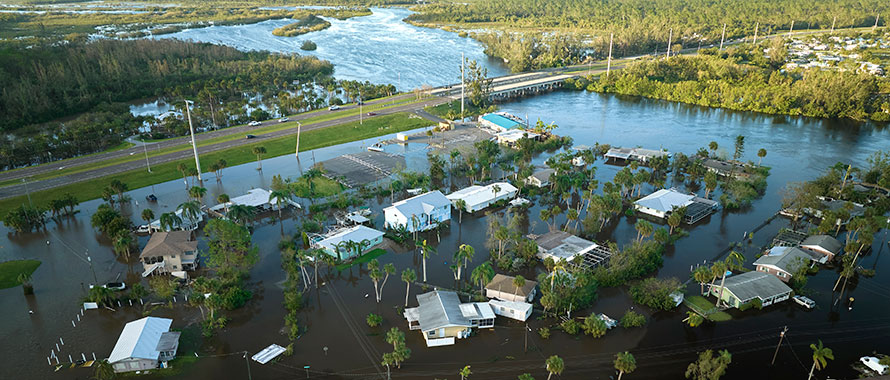A number of homeowners around Fort Myers Beach, Florida, are expressing frustration over the status of their insurance claims related to damage from Hurricane Ian. According to a recent New York Post report, more than 25% of closed insurance claims in Lee County have been denied, over 30,000 claims are still pending, and some of the 135,000-plus claims that were paid involved what the homeowners called “lowball” payouts.
The vice mayor of Fort Myers Beach told the news outlet that the situation was shocking, with homeowners left “desperate” and some living in damaged homes without utilities.
Featured Solutions
“The main thing that we see, especially down in Florida, is that homeowners just do not have Flood Insurance,” said Jacob Martin, Manager, Flood, Burns & Wilcox, Charlotte, North Carolina. “A lot of individuals are not aware that a standard Homeowners Insurance policy does not cover flood. They often try to get their Homeowners Insurance to pay for that claim, arguing that it was caused by wind, and there is just rampant litigation in Florida over things like this.”

There are homeowners saying they are paying a mortgage on a house that does not exist anymore. It is heartbreaking. These individuals are displaced, they cannot live in their homes, and it is a long process to figure out where to go from there.
Data from the state’s chief financial officer showed that 4,719 complaints had been filed against insurers related to the hurricane, WFLA reported on Feb. 27. In Lee County, officials have launched a task force to help residents and businesses recover.
“There are homeowners saying they are paying a mortgage on a house that does not exist anymore. It is heartbreaking,” said Brad Turner, Associate Vice President, National Product Manager, Flood, Morehead City, North Carolina. “These individuals are displaced, they cannot live in their homes, and it is a long process to figure out where to go from there.”
Lack of Flood Insurance created ‘nightmare’
In the days after Hurricane Ian, which the Associated Press reported was the second-deadliest storm to hit the continental U.S. this century, news reports painted a bleak picture of the potential impact on homeowners who did not have Flood Insurance. Data from CoreLogic estimated uninsured flood losses at between $10 billion and $17 billion, CNN reported on Oct. 7, and NBC News noted that the hurricane exposed a Flood Insurance “nightmare” for Floridians because so many did not carry the coverage.
“It is estimated that only 15% of the affected property owners were carrying flood coverage” Turner said of homeowners in the state who have Flood Insurance. “In contrast, Florida remains one of the highest exposed states in the country to flood risk and tropical frequency.”
Additionally, the hurricane brought significant flooding in areas that were not considered to be at high risk for flood, the Associated Press reported Oct. 7. One resident who got 14 inches of water in her home told the news outlet that no one in her neighborhood had Flood Insurance because they believed their homes were in a non-flooding area.

Flood zones determine whether you are required by your mortgage company to buy Flood Insurance. We would encourage folks to talk to a flood expert and figure out what their actual exposure is.
Unfortunately, Turner said, “flood zones have become an antiquated way to review exposure at this point,” and better tools are available to help homeowners understand their risk.
Flood zones are often designated by the chance of a flood occurring once in 100 or 500 years, for example, but even that estimated frequency “does not mean you are not exposed,” Martin added. “Flood zones determine whether you are required by your mortgage company to buy Flood Insurance,” he said. “We would encourage folks to talk to a flood expert and figure out what their actual exposure is.”
Turner agreed: “The largest driver of Flood Insurance purchase in the U.S. is lender requirement for a mortgage, but an escalated number of properties are now experiencing loss in these areas where it is not mandatory,” he said. “Property owners will typically have wind coverage under their Homeowners Insurance/Wind policy, but if there is any kind of flood damage, there could be a large portion of the loss uninsured through a standard homeowner’s policy. If you have both policies, you have a good foundation to cover what is insurable.”
There is “a fine line” between wind and flood damage within the adjustment process, he explained, which can extend the claims process as professionals work to sort through the cause or causes of loss. “Especially with these tropical events, you could potentially have a lot of crossovers between the two perils,” he said. “Purchasing both policies is the best way to solidify coverage through a tropical event and prevent unexpected expense and uncovered loss.”
Differences between NFIP, private market policies
Although the lack of Flood Insurance seems to be a primary factor in many of the insurance problems homeowners have reported in the wake of Hurricane Ian, even those who do have both wind and flood policies could face issues based on the amount and type of coverage they purchased, Turner said. “There is also sometimes the expectation of getting more money than what their policy was designed to cover,” he said. Due to inflation, “many individuals are expecting larger payouts but the limits do not align with what it costs to reconstruct the home.”
In a recent survey, 56% of homeowners said they had not reviewed their Homeowners Insurance policy in the past year and, of those who did, just 9% increased their coverage for inflation and increased rebuilding costs, Fox Business reported on Feb. 27.

This is one of the benefits of the private Flood Insurance market. We have the ability to enhance and increase coverage beyond what a typical NFIP policy would cover.
Flood Insurance is available through FEMA’s National Flood Insurance Program (NFIP) or through the private insurance market, which can generally provide higher limits and certain coverages not available through NFIP policies. For example, private Flood Insurance policies can cover basement property, swimming pools, landscaping, and loss of use, according to Martin.
“I would really encourage homeowners to have a good understanding of what type of exclusions exist in their policy,” Martin said. “This is one of the benefits of the private Flood Insurance market. We have the ability to enhance and increase coverage beyond what a typical NFIP policy would cover.”
These distinctions are important for commercial property owners, as well, who may be more likely to consider Flood Insurance but could still find themselves without enough coverage in the event of a loss. “We get a lot of requests from business owners about coverage for loss of business income,” Martin said, adding that this is available with private policies but not the NFIP. “We can also offer coverage for replacement cost, whereas a typical NFIP would cover actual cash value only.”
According to Turner, commercial property owners “tend to have a higher level of insurance across the board,” and policy terms are similar between personal and commercial flood policies. Business owners who do not yet have Flood Insurance should take note of the devastation so many communities have seen following major storms, he said.
“Looking at what is happening to those families, if your building was destroyed on the first level, how would that affect your business? Those sorts of things are really important to ask yourself,” Turner said. “How is that going to affect your operations? Limits become a very big thing to focus on with commercial entities as well.”
A newer flood-related option available for business owners is parametric coverage, in which an insurance carrier physically installs sensors on a commercial property that will monitor for water hitting the sensor at a certain height. “It allows a commercial entity to get a payout much quicker, typically in less than a week,” he said.
For both homeowners and business owners, “understanding your risk is very important,” he said, along with understanding exactly what your Flood Insurance covers.
“It is good to read your policy, read the exclusions, and understand what your policy does and does not cover,” Turner said. “Insurance professionals also need to set the expectation, which is why it is always important to partner with knowledgeable brokers. Once a claim happens, it is not the time to figure out what is covered.”
By working with an expert, Martin said, property owners can “make sure they understand what is in their policy language so that at the time of a claim, there are no surprises.”
New law will require some Florida residents to purchase Flood Insurance
For many property owners in Florida, opting out of Flood Insurance may not be a choice in the future. Late last year, Florida lawmakers passed legislation that will require all policyholders with Citizens to eventually carry insurance coverage for flood, WFLA reported on Dec. 19, 2022. The changes begin to go into effect April 1, though some homeowners will have until 2027 before they are required to buy the coverage, according to Citizens.
“I think this will be a very good and impactful change for residents of Florida,” Martin said. “There are a lot of other places in the country where this type of change would be very helpful, as well”

In the system we have right now, too many individuals are uninsured or underinsured, and inflation is exacerbating the problems.
By requiring homeowners to have both Flood Insurance and Homeowners Insurance, the risk of “crossover” disputes between insurance carriers is avoided, Turner said.
“A lot of carriers have pulled out of Florida because of litigation or insolvency. Florida is a very tough state and tough market right now, and the Citizens program is being relied on, so it does make sense,” he said of the new law. “This is a big hot topic not only in Florida but elsewhere, too. In the system we have right now, too many individuals are uninsured or underinsured, and inflation is exacerbating the problems.”








